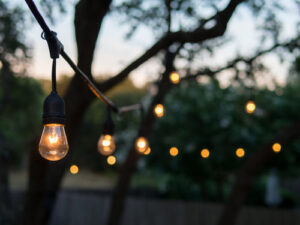Outdoor lighting plays a crucial role in enhancing the aesthetics, safety, and functionality of your outdoor space. Whether you’re illuminating a pathway, highlighting landscaping features, or providing security lighting, choosing the right outdoor lighting fixtures is essential. In this comprehensive guide, we’ll explore the factors to consider when selecting electrical outdoor lighting and provide tips for making the best choices for your home.
Understanding the Importance of Outdoor Lighting
Aesthetic Enhancement
Well-designed outdoor lighting can enhance the visual appeal of your home’s exterior. By strategically placing lighting fixtures, you can create ambiance, highlight architectural features, and showcase landscaping elements such as trees, shrubs, and flower beds.
Safety and Security
Outdoor lighting also plays a critical role in enhancing safety and security around your property. Properly illuminated pathways, driveways, and entryways reduce the risk of trips and falls, while security lighting deters potential intruders and enhances visibility during nighttime hours.
Extended Outdoor Living Spaces
With the right outdoor lighting scheme, you can extend the usability of your outdoor living spaces well into the evening hours. Whether you’re hosting outdoor gatherings, enjoying a quiet evening on the patio, or cooking dinner on the grill, adequate lighting ensures that you can do so safely and comfortably.
Factors to Consider When Choosing Outdoor Lighting
Purpose and Functionality
Before selecting outdoor lighting fixtures, consider the specific purposes they will serve. Are you looking to illuminate pathways, accentuate landscaping, or provide security lighting? Identifying the primary functions of your outdoor lighting will help you narrow down your options and choose the most suitable fixtures for your needs.
Style and Design
Outdoor lighting fixtures come in a wide range of styles, from traditional lanterns to modern sconces and spotlights. Consider the architectural style of your home and existing outdoor decor when selecting lighting fixtures to ensure a cohesive look. Additionally, choose fixtures that complement the overall design aesthetic of your outdoor space.
Energy Efficiency
Opting for energy-efficient outdoor lighting not only helps reduce your carbon footprint but also saves you money on energy bills in the long run. Look for fixtures with LED bulbs, which consume less energy and have a longer lifespan than traditional incandescent bulbs. Additionally, consider installing motion sensors or timers to further reduce energy consumption.
Durability and Weather Resistance
Outdoor lighting fixtures are exposed to the elements year-round, so it’s essential to choose fixtures that are durable and weather-resistant. Look for fixtures constructed from materials such as aluminum, stainless steel, or weatherproof plastics that can withstand rain, snow, and extreme temperatures without corroding or deteriorating.
Ease of Installation and Maintenance
Consider the ease of installation and maintenance when choosing outdoor lighting fixtures, especially if you plan to install them yourself. Opt for fixtures that are easy to mount and wire, and consider hiring a professional electrician for more complex installations. Additionally, choose fixtures that are easy to clean and maintain to ensure they remain in optimal condition.
Tips for Choosing Specific Types of Outdoor Lighting
Pathway Lighting
When selecting pathway lighting, opt for fixtures that provide adequate illumination without creating glare or harsh shadows. Choose fixtures with shielded bulbs or frosted lenses to diffuse light evenly along the pathway, enhancing safety and visibility.
Landscape Lighting
For landscape lighting, consider fixtures with adjustable heads or beams that allow you to direct light precisely where it’s needed. Choose fixtures with a variety of beam angles to highlight different landscaping features, such as trees, sculptures, or water features.
Security Lighting
When choosing security lighting, prioritize fixtures with motion sensors or dusk-to-dawn sensors that automatically turn on when motion is detected or when ambient light levels decrease. Position security lights strategically around your property to deter potential intruders and provide enhanced visibility.
Accent Lighting
Accent lighting is ideal for highlighting architectural elements, such as columns, arches, or facades. Choose fixtures with a narrow beam angle and adjustable heads to direct light precisely where it’s needed, creating dramatic effects and visual interest.
Hiring a Professional Electrician for Outdoor Lighting Installation
While some outdoor lighting installations can be DIY projects, more complex installations may require the expertise of a professional electrician. A licensed electrician can ensure that your outdoor lighting is installed safely and correctly, adhering to local building codes and regulations. Additionally, hiring a professional can save you time and hassle while providing peace of mind that your outdoor lighting will function reliably for years to come.
Conclusion
Choosing the right electrical outdoor lighting is essential for enhancing the aesthetics, safety, and functionality of your outdoor space. By considering factors such as purpose, style, energy efficiency, durability, and ease of installation, you can select lighting fixtures that meet your specific needs and preferences. Whether you’re illuminating pathways, accentuating landscaping, providing security lighting, or enhancing architectural features, there are a variety of outdoor lighting options available to suit every style and budget.
If you’re unsure about the best outdoor lighting options for your home or if you’re considering more complex installations, don’t hesitate to consult with a professional electrician. A licensed electrician can provide expert guidance and ensure that your outdoor lighting is installed safely and correctly, allowing you to enjoy your outdoor space to the fullest.
Need Electrical Contractors in Alexandria, VA?
Welcome to Walsh Electric! Since 1985, we’ve been providing exceptional electrical services to the greater DC area. We specialize in electrical repairs, upgrades, maintenance, and everything in between Additionally, we are NFPA and NETA certified, and have an outstanding relationship with the Better Business Bureau. Call us today!



